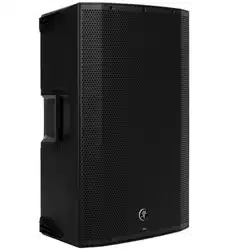Loading ...
Loading ...
Loading ...

Owner’s Manual
13
Owner’s Manual
EQ Setup | Access Menu
Now, the bottom row also houses input channels 1, 2
and BT. But instead of raising or lowering levels, this is
where to adjust each channels’ EQ. Additonally, this is
where to access the Menu screen.
In order to change a channel’s EQ, push the speaker
control knob when the desired channel’s EQ icon is
illuminated.
Next, push the speaker control knob again once the
EQ you want to change is illuminated. See below.
The EQ ranges are as follows:
• High: ±12 dB
@ 6 kHz [Channels 1 and 2]
@ 12 kHz [Bluetooth]
• Mid: ±12 dB @ 2.5 kHz
• Low: ±12 dB @ 80 Hz
• HPF: 20 Hz – 400 Hz at 12 dB per octave
[Channels 1 and 2 only]
1 2 BT Main 1 2 BT Main
1 2 BT Main 1 2 BT Main
1
High 0dB
Mid 0dB
Low 0dB
HPF 20Hz
1
High 0dB
Mid 0dB
Low 0dB
HPF 20Hz
1
High 0dB
Mid 0dB
Low 0dB
HPF 20Hz
1
High 0dB
Mid 0dB
Low 0dB
HPF 20Hz
As seen below, we changed the channel 1 high,
mid and low EQ to +5 and the HPF setting to 110 Hz.
Press the speaker control knob to return to the previous
screen once the EQ settings you desire have been dialed
in.
In addition to the four EQ choices shown above,
there’s a fifth and final selection: the left-facing arrow.
Illuminating and selecting this simply returns you
to the main mixer screen.
Other than the aforementioned EQ settings screen,
this is also where to access the menu screen. From the
mixer screen, simply rotate the speaker control knob
right until the bottom right icon is illuminated (A).
Then push the knob to enter the menu screen (B).
Let’s take a look and see what the menu screen does.
The first step is to flip the page!
1
Mid 0dB
Low 0dB
HPF 20Hz
High +5
1
Low 0dB
HPF 20Hz
High 0dB
Mid +5
1
Mid 0dB
HPF 20Hz
Low +5
1
Mid 0dB
Low 0dB
HPF 110Hz
High 0dB High 0dB
1
High 0dB
Mid 0dB
Low 0dB
HPF 20Hz
MIXER
CONFIG LOCK LCD
MODE BT
1 2 BT Main
(A) (B)
Loading ...
Loading ...
Loading ...
